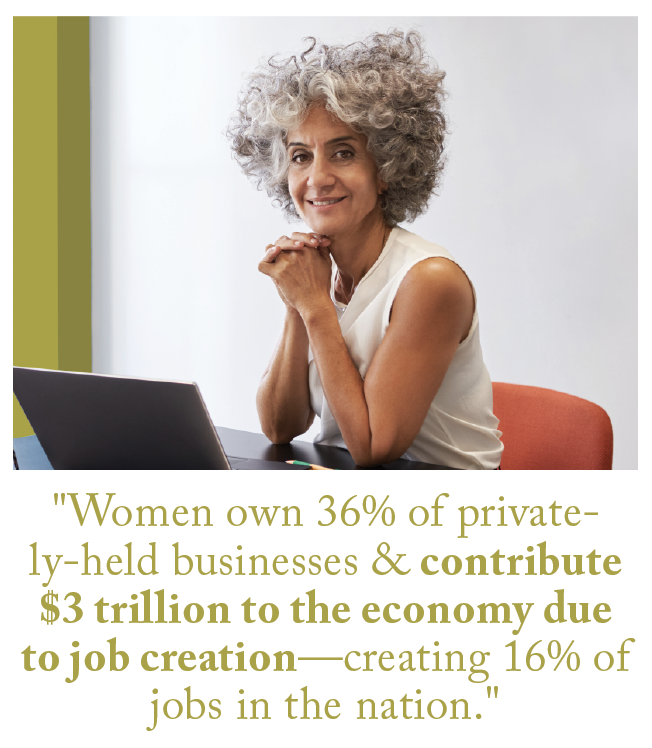Capital is pivotal for the success of any entrepreneur to launch a sustainable and lucrative business. Traditional routes of access to capital are changing as technological development creates new avenues, and the distance between entrepreneur and investor decreases due to an increase in fast and efficient communication.
The 2019 NAWRB Women Housing Ecosystem Report (WHER), the third installment of the most diverse coverage of the housing ecosystem with over sixty resources in six volumes, explains in detail how the advent of gender lens investment and diversity certification has made it easier for entrepreneurs to access modest amounts of capital and opportunities for government contracting. NAWRB is proud to be one of 11 U.S. Small Business Administration (SBA)’s women-owned small business resource partners.
Women entrepreneurs have notoriously faced hardships in gaining access to capital, from lack of information and resources and local and state government assistance, to facing cultural biases from investors. Without adequate capital, women cannot make their creative ideas a reality, nor can they afford to maintain the businesses that provide jobs for a significant portion of the population.
According to U.S. Census Bureau data, women own 36 percent of privately-held businesses and contribute $3 trillion to the economy due to job creation—creating 16 percent of jobs in the nation.
The desire to accumulate money is a reason why some women are driven to start their own business, but a lack of it can drive them out of a traditional way of making a living in America. Entrepreneurship is a tried and true way of generating wealth and women are driven to self-employment for its other benefits as well, including the ability to be their own boss, work flexible hours and do something that they are passionate about and enjoy.
As more women become their own bosses, they compose a larger share of small businesses, of which 80 percent have no employees other than the owner, in the United States. In 2013, there were 28.8 million small businesses in the United States.
Government Contracting
In March 2019, the U.S. Small Business Administration (SBA) announced that the federal government presently awards $22.9 billion in federal small business contracts to women-owned small businesses. It achieved its small business procurement goal for the sixth year in a row, awarding 25.05 percent ($120 billion) of federal contracts to small businesses.
Service-Disabled Veteran-Owned Small Businesses (SDVOSBs) received 4.27 percent ($20.6 billion) of federal small business eligible contracts. Small Disadvantaged Businesses (SDB) were awarded 9.65 percent ($46.5 billion) of small business eligible contracts.
As with the SBA, there are government contracting opportunities for women entrepreneurs with diverse agencies: In FY 2018, the Federal Housing Finance Agency (FHFA) “obligated” about $44.9 million of its total contracting dollars to minority- and women-owned businesses, an approximate $1.2 million increase from FY 2017.
The Federal Deposit Insurance Corporation (FDIC) awarded $212.9 million in contracts in 2018, of which $38.4 million went to women-owned businesses (WOB) and $56.7 million to minority women-owned businesses (MWOB). In FY 2017, the Consumer Financial Protection Bureau’s (CFPB) total spend was $169,441,229, of which $51,995,823 (30.7 percent) was spent with minority-owned and women-owned businesses.
From public utility companies and those companies working with government agencies direct or indirect, the entities searching for diverse firms is increasing, and business certification can help bring you to the forefront. Here’s the most important part: agencies and entities cannot help source more diversity if they do not know you exist. The importance and value of certifying your business cannot be overstated.
A pivotal benefit of leveraging your business’s diversity classification is the network you will create. As you solidify yourself in a community of diverse entrepreneurs, you can benefit from referring and being referred for business opportunities and government contracting. With their potential to fuel business sustainability, the prospects that come from diversity classification cannot be ignored.
Knowing that you’re a women-owned business can represent significant appeal to buyers wanting to work with women. According to Bloomberg, women make 85 percent of all purchasing decisions—and 91 percent of new home purchasing decisions—in the U.S. If you leverage your women-owned business certification, you are giving yourself a leg up on the competition before even shaking hands with your client.
Diversity Classification
In addition to government contracting, diversity classification can open your business to newfound streams of funding, from banks to venture capital dollars. A diversity certification is a denotation awarded to businesses that are at least 51 percent owned by a disadvantaged member of the population. For instance, a women-owned business must be 51 percent owned, managed and operated by women. NAWRB is one of the few third-party women-owned business certifiers.
Resources for Women-Owned Businesses
- Union Bank Diversity Lending Program for women, minorities and veteran entrepreneurs
- Women’s Business Centers
- Women’s Venture Fund
- Women’s Capital Connection
- InnovateHER Women Business Challenge
- The Amber Grant
Resources for Minority-Owned Businesses
- Minority Business Development Agency
- National Minority Supplier Development Council
- JPMorgan Chase Small Business Forward Program for women, minorities and veteran entrepreneurs
- SBA 7(a) Loans & 8(a) Business Development Program
- Accion U.S. Network
- The National African American Small Business Loan Fund
Resources for Veteran-Owned Businesses
- SBA Veterans Advantage
- Loans from financial institutions in the SBA Preferred Lender Program
- Leveraging Information and Networks to Access Capital (LINC): This online matchmaking service, connects small business owners with nonprofit lenders that offer free financial advice and specialize in microlending, smaller loans (SBA Community Advantage program), and real estate financing (SBA 504 loan program).
- SBA Veterans Advantage: Guarantees loans approved to businesses owned by veterans or military spouses
- SBA Veteran’s Entrepreneurship Act of 2015: Reduces the upfront borrower fee to zero dollars for eligible veterans and military spouses for SBA Express loans up to $350,000.

Gender Lens Investment
Women entrepreneurs have trouble raising capital, especially through business angel and venture sources, but there are ways to combat this problem. One important way is to demonstrate to venture capital firms the benefit of having more diverse management teams, including higher performance and greater investment opportunities available for women entrepreneurs.
One up-and-coming trend in impact investing is gender lens investment. According to Veris Wealth Partners, investment of this type has risen 41 percent in the past year, up to $910 million. In addition, the number of mandated publicly traded gender lens investment strategies has reached a total of 22, after 5 years of steady growth. This is a wonderful increase from the years 1993 to 2012, when there were only 5 strategies for gender lens investing.
This type of investment focuses on women by evaluating opportunities based on how a certain investment will facilitate the following concerns:
- Women’s leadership
- Women’s access to capital
- Products and services that help women and girls
- Equality in the workplace
- Shareholder engagement and policy work
- Women investing their own resources
If an investment satisfies at least one of these criteria, some wealth management companies believe it will have a positive impact on the economic opportunities and growth for women and girls.
Crowdfunding
Crowdfunding is an efficient way to gain capital from many individuals through small donations, and is low risk compared to venture angels and banks. A 2019 Statista report estimates that $17.2 billion is invested annually in North America through crowdfunding websites, a number that is increasing with each subsequent year. Statista projects a compound annual growth rate of 14.7 percent for the next four years. Top crowdfunding platforms include Kickstarter, Indiegogo, GoFundMe, CircleUp, Patreon, Crowdrise, Razoo, AngelList and many more.
A report from the National Women’s Business Council (NWBC), Crowdfunding as a Capital Source for Women Entrepreneurs, explores the relationship between crowdfunding and women entrepreneurs, aiming to garner a deeper understanding of crowdfunding as a source of business capital.
As the report articulates, crowdfunding is an “alternative finance solution that attempts to fill the gap left by traditional financing sources, especially as it relates to small and medium enterprises (SME) financing needs.” Usually taking place on websites, crowdfunding is fueled by social media exposure making it easier to reach larger networks of would-be investors with an entrepreneur’s business venture.
According to crowdfunding platform Kickstarter, female participation has remained constant between 29 and 31 percent. Women, on average, are 9 percent more successful than their male counterparts. The average funding goal set by men is consistently higher than that set by women; however, Kickstarter notes that the average amount pledged was the same for goals set by either men or women. Lower funding goals correlate to higher funding success rates, but evidence also supports that women’s stronger social networks contribute to their higher success rate.
Crowdfunding has the potential to fill a significant role in the future of business capital, growing formidably in the past 15 years alone. Although the report acknowledges that further research is needed to fully determine the role and effect of crowdfunding in women’s entrepreneurship, it holds a reasonable capacity to support women entrepreneurs and investors in the business ecosystem.
What are some innovative ways that women entrepreneurs can leverage crowdfunding to their advantage? Here are a few suggestions for making the most of this unique capital resource:
- Women entrepreneurs can test product market fit, build their network, test product lines and have friends they support return the favor.
- Utilize your social media presence in getting your business’s name out there and building a community who support and promote your product.
- Supportive networks, effective communication and social media presence will bring greater success.
Online Lending Tools
An emerging means for access to capital for small businesses in particular are online lending tools. The 2017 Kauffman Foundation report states that many businesses are in need of funds to manage cash flow and to access short-term financing, and the most commonly used tools—as estimated by a study by a 2015 Federal Reserve Bank of New York study—are loans and lines of credit.
Small businesses are becoming attracted to merchant cash advances, with 7 percent using merchant cash advances in 2014. As women owned 12.3 million out of a total 28.8 million U.S. small businesses in 2013, according to the U.S. Small Business Administration Office of Advocacy, women entrepreneurs are most likely to be those that are leveraging this option.
Fintech companies like OnDeck and Kabbage are facilitating small businesses’ access to credit in online lending by providing fast online vetting for small business loans, utilizing personal data as well as credit scores. Their services have made it easier for financial institutions to make quicker decisions regarding lending, saving both time and money for small investment amounts.
Traditional means of gaining access to capital, which typically involved a long and cost-intensive process, are being expanded with online options, which provide smaller loan amounts faster and at lower costs. Whether they decide to leverage crowdfunding, merchant cash advances or sector-focused angel syndicates like gender-lens investment, women entrepreneurs in need of funds for their startup or capital for their business have new tools at their disposal. In time, these online platforms may become the new norm for individuals budding into entrepreneurship.
Even in this new technologically-advanced age, relationships are everything. For the last 30 years, NAWRB’s executive management has been building deep financial resources. One type of financing does not meet every need in the industry. Let us help you find out which one is right for your business!

 Login
Login

